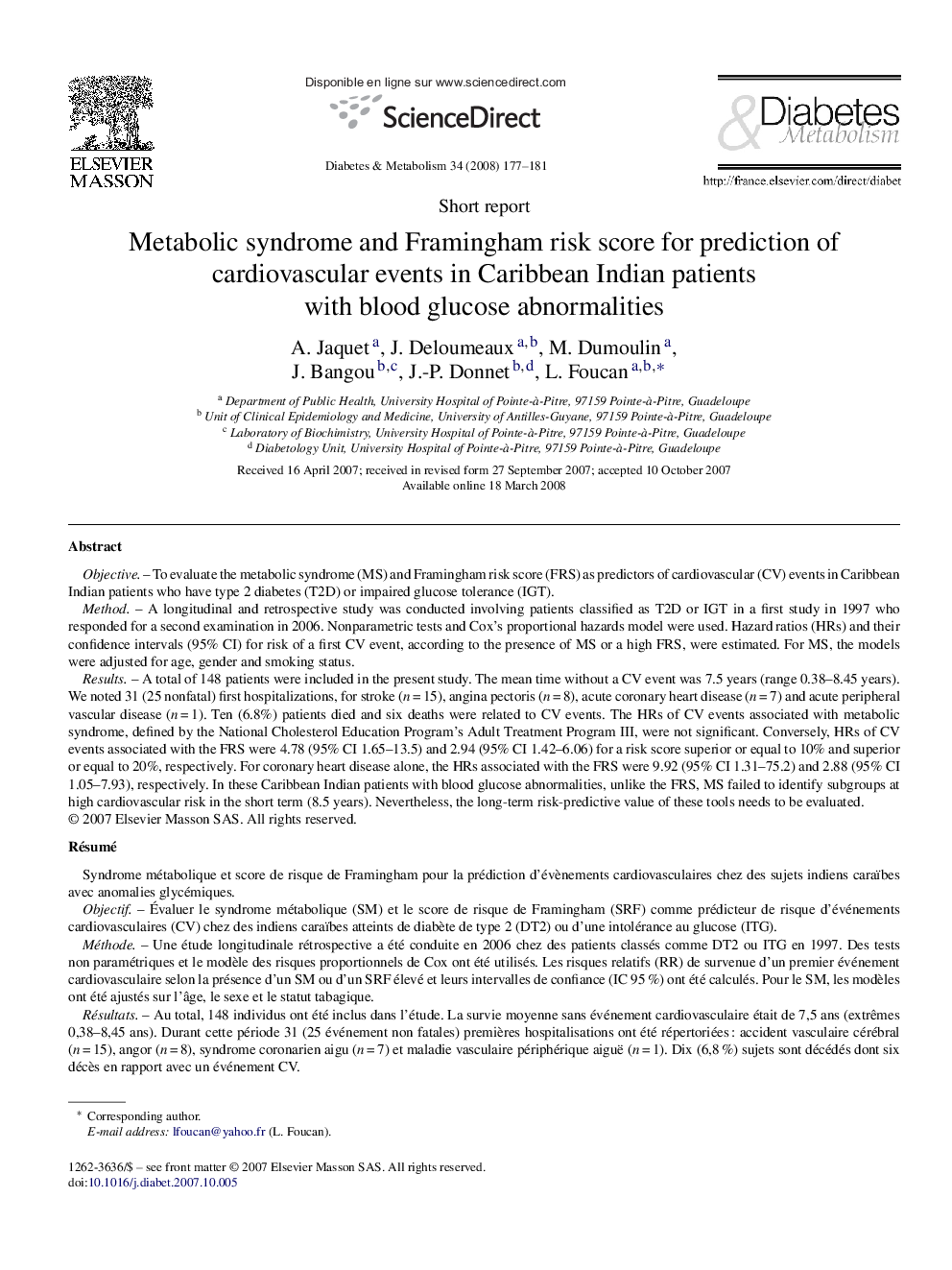| کد مقاله | کد نشریه | سال انتشار | مقاله انگلیسی | نسخه تمام متن |
|---|---|---|---|---|
| 3260880 | 1207642 | 2008 | 5 صفحه PDF | دانلود رایگان |

ObjectiveTo evaluate the metabolic syndrome (MS) and Framingham risk score (FRS) as predictors of cardiovascular (CV) events in Caribbean Indian patients who have type 2 diabetes (T2D) or impaired glucose tolerance (IGT).MethodA longitudinal and retrospective study was conducted involving patients classified as T2D or IGT in a first study in 1997 who responded for a second examination in 2006. Nonparametric tests and Cox's proportional hazards model were used. Hazard ratios (HRs) and their confidence intervals (95% CI) for risk of a first CV event, according to the presence of MS or a high FRS, were estimated. For MS, the models were adjusted for age, gender and smoking status.ResultsA total of 148 patients were included in the present study. The mean time without a CV event was 7.5 years (range 0.38–8.45 years). We noted 31 (25 nonfatal) first hospitalizations, for stroke (n = 15), angina pectoris (n = 8), acute coronary heart disease (n = 7) and acute peripheral vascular disease (n = 1). Ten (6.8%) patients died and six deaths were related to CV events. The HRs of CV events associated with metabolic syndrome, defined by the National Cholesterol Education Program's Adult Treatment Program III, were not significant. Conversely, HRs of CV events associated with the FRS were 4.78 (95% CI 1.65–13.5) and 2.94 (95% CI 1.42–6.06) for a risk score superior or equal to 10% and superior or equal to 20%, respectively. For coronary heart disease alone, the HRs associated with the FRS were 9.92 (95% CI 1.31–75.2) and 2.88 (95% CI 1.05–7.93), respectively. In these Caribbean Indian patients with blood glucose abnormalities, unlike the FRS, MS failed to identify subgroups at high cardiovascular risk in the short term (8.5 years). Nevertheless, the long-term risk-predictive value of these tools needs to be evaluated.
RésuméObjectifÉvaluer le syndrome métabolique (SM) et le score de risque de Framingham (SRF) comme prédicteur de risque d’événements cardiovasculaires (CV) chez des indiens caraïbes atteints de diabète de type 2 (DT2) ou d’une intolérance au glucose (ITG).MéthodeUne étude longitudinale rétrospective a été conduite en 2006 chez des patients classés comme DT2 ou ITG en 1997. Des tests non paramétriques et le modèle des risques proportionnels de Cox ont été utilisés. Les risques relatifs (RR) de survenue d’un premier événement cardiovasculaire selon la présence d’un SM ou d’un SRF élevé et leurs intervalles de confiance (IC 95 %) ont été calculés. Pour le SM, les modèles ont été ajustés sur l’âge, le sexe et le statut tabagique.RésultatsAu total, 148 individus ont été inclus dans l’étude. La survie moyenne sans événement cardiovasculaire était de 7,5 ans (extrêmes 0,38–8,45 ans). Durant cette période 31 (25 événement non fatales) premières hospitalisations ont été répertoriées : accident vasculaire cérébral (n = 15), angor (n = 8), syndrome coronarien aigu (n = 7) et maladie vasculaire périphérique aiguë (n = 1). Dix (6,8 %) sujets sont décédés dont six décès en rapport avec un événement CV. Les risques relatifs d’évènements CV associés au SM (défini selon la National Cholesterol Education Program's Adult Treatment Program III et l’International Diabetes Federation) étaient non significatifs. À l’inverse, les RR associés au SRF étaient de 4,78 (IC 95 % 1,65–13,5) et 2,94 (IC 95 % 1,42–6,06) pour un score de risque, respectivement supérieur à 10 et 20 %. En considérant uniquement la maladie coronaire, les RR associés au SRF étaient, respectivement, de 9,92 (IC 95 % 1,31–75,2) et 2,88 (IC 95 % 1,05–7,93).Chez ces sujets indiens atteints d’une anomalie glycémique, le syndrome métabolique ne permet pas d’identifier à court terme (8,5 ans) les sujets à haut risque cardiovasculaire à l’inverse du score de Framingham. Néanmoins, la valeur prédictive à long terme de ces deux outils devrait être évaluée.
Journal: Diabetes & Metabolism - Volume 34, Issue 2, April 2008, Pages 177–181